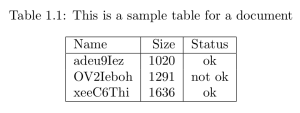...
Common are references and labels for chapters, sections, tables and figures
| Code Block |
|---|
\chapter{ASample sampleCosting ChapterGuidelines\label{sid:chapter_sample_costing}}
as can be seen in Chapter~\ref{{sid:chapter_sample_costing}
|
| Panel |
|---|
|
Tables
A LaTeX table environment has the following structure:
...
It starts with a \begin{table} environment then the \caption takes care of putting in the table caption, the label sets a mark, so it can be referred to in the following text using \ref
The \begin{center}the centers the actual table environment \begin{tabular}.
The {|l|r|c|} tells LaTeX to make a table with three columns, aligned left right and centered and \hline draws a horizontal line
Individual columns are separated with \& and are ended with a double-slash
The output is shown below:
Tables can almost be infinitely complex, hence this chapter is a recommended read.
Figures
Figures work pretty much the same as tables
| Code Block |
|---|
\begin{figure}
\includegraphics{image.pdf}
\caption{\label{sid:chapter_sample_figure1} This is a sample figure for a document}
\end{figure}
|
the actual image is include with the \includegraphics command. It has some useful options to scale an image
- [scale=0.8] will scale the picture by a factor of 0.8
- [width=0.5\textwidth]will make the picture width to be 80 % of the total text width
there are preferrable to giving absolute sizes
- [width=10cm]
- [height= 3in]
So including a figure looks like:
| Code Block |
|---|
\begin{figure}
\includegraphics[width=0.6\textwidth]{image2.pdf}
\caption{\label{sid:chapter_sample_figure2} This is a second sample figure for a document}
\end{figure}
|
Details can be found here
Note:
- If the Figure file isn't available, LaTeX will complain but usually continue building. It is important to specify the path of the file location relative to the build directory.
- Concerning file formats, check the FAQ
Special Characters
Seehttp://en.wikibooks.org/wiki/LaTeX/Accents with a whole summary of Accents and special characters
Citations
will be handled using BibTeX, hence it needs some additional steps. In the LaTeX document you refer to the article book, etc.with
| Code Block |
|---|
\cite{Aaltonen:2011rt}
|
however in the central bibliography file (common for everyone} you have to add a piece giving all the information for your document
| Code Block |
|---|
@article{Aaltonen:2011rt,
author = "Aaltonen, T. and others",
title = "{Search for Standard Model Higgs Boson Production in
Association with a $W$ Boson Using a Matrix Element
Technique at CDF in $p\bar{p}$ Collisions at $\sqrt{s} =
1.96$ TeV}",
collaboration = "CDF Collaboration",
journal = "Phys.Rev.",
volume = "D85",
pages = "072001",
year = "2012",
eprint = "1112.4358",
archivePrefix = "arXiv",
primaryClass = "hep-ex",
reportNumber = "FERMILAB-PUB-11-664-E",
SLACcitation = "%%CITATION = ARXIV:1112.4358;%%",
}
|
BibTeX will the generated the references centrally for the entire document. For the DBD, just send the information to the references maestro who'll insert it into the central database and the just refer to it with \cite. Everything else will be taken care of by the build script.
Spires/Inspire has already an automatic tool to generate BibTeX entries.
